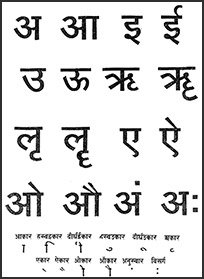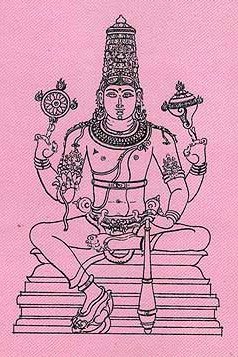Mulaprakriti, Mula-prakriti, Mūlaprakṛti: 15 definitions
Introduction:
Mulaprakriti means something in Hinduism, Sanskrit, the history of ancient India, Marathi. If you want to know the exact meaning, history, etymology or English translation of this term then check out the descriptions on this page. Add your comment or reference to a book if you want to contribute to this summary article.
The Sanskrit term Mūlaprakṛti can be transliterated into English as Mulaprakrti or Mulaprakriti, using the IAST transliteration scheme (?).
In Hinduism
Purana and Itihasa (epic history)
Source: archive.org: Shiva Purana - English TranslationMūlaprakṛti (मूलप्रकृति) refers to the “original Prakṛti” and is used to describe Śiva, in the Śivapurāṇa 2.2.15. Accordingly as Brahmā narrated to Nārada:—“[...] On arrival there, after paying respects to the lord [Śiva] with great excitement we lauded Him with various hymns with palms joined in reverence. The Devas said: [...] Obeisance to the original Prakṛti [viz., Mūlaprakṛti], the great presiding deity of everything. Obeisance to Thee the great Puruṣa, the great lord, the bestower of all”.
Source: Cologne Digital Sanskrit Dictionaries: The Purana IndexMūlaprakṛti (मूलप्रकृति).—The root cause or māyā is Lakṣmī and the Puruṣa is Vāsudeva.*
- * Brahmāṇḍa-purāṇa IV. 8. 28.

The Purana (पुराण, purāṇas) refers to Sanskrit literature preserving ancient India’s vast cultural history, including historical legends, religious ceremonies, various arts and sciences. The eighteen mahapuranas total over 400,000 shlokas (metrical couplets) and date to at least several centuries BCE.
Vyakarana (Sanskrit grammar)
Source: Wikisource: A dictionary of Sanskrit grammarMūlaprakṛti (मूलप्रकृति).—The original base of the word used in language; the root and the praatipadika; the word परमप्रकृति (paramaprakṛti) is also used in the same sense.

Vyakarana (व्याकरण, vyākaraṇa) refers to Sanskrit grammar and represents one of the six additional sciences (vedanga) to be studied along with the Vedas. Vyakarana concerns itself with the rules of Sanskrit grammar and linguistic analysis in order to establish the correct context of words and sentences.
Pancaratra (worship of Nārāyaṇa)
Source: Google Books: The Goddess Lakṣmī: The Divine Consort in South Indian Vaiṣṇava TraditionMūlaprakṛti (मूलप्रकृति) refers to “root-matter” which emerges after the manifestation of the kūṭastha-puruṣa and the māyā-śakti, according to the Lakṣmītantra dealing with the philosophy of the Pañcarātra.—During the intermediary creation (śuddhetara) there are two manifestations from the bhūti-śakti—kūṭastha-puruṣa (aggregate of souls) and māyā-śakti (non-spiritual energy). [...] After the manifestation of the kūṭastha-puruṣa and the māyā-śakti, the vyūha, called Aniruddha, becomes responsible for the emergence of śakti (identified as mūlaprakṛti—root-matter). [...]
Analogous to the Sāṅkhya system, the tattvas emerge from the mūlaprakṛti in the following way: From the avyakta-prakṛti (unmanifest root-matter) emerges mahat; buddhi is an aspect of mahat and not identical with mahat as in the Sāṅkhya system. From mahat emerges the ahaṃkāra (ego), and from ahaṃkāra the manas. From ahaṃkāra emerge the five mahābhūtas (space, wind, fire, water, and earth), five tanmātras (sound, touch, form, taste, and smell), five buddhīndriyas (hearing. feeling, seeing, tasting, and smelling), and five karmendriyas (speaking, grasping, walking, excreting, and generating). With the appearance of the tattvas, the cosmic night ends, and the cosmic day begins. [...]

Pancaratra (पाञ्चरात्र, pāñcarātra) represents a tradition of Hinduism where Narayana is revered and worshipped. Closeley related to Vaishnavism, the Pancaratra literature includes various Agamas and tantras incorporating many Vaishnava philosophies.
General definition (in Hinduism)
Source: WikiPedia: HinduismMulaprakruti can be translated as "the root of nature" or "root of Prakruti"; it is a closer definition of 'fundamental matter'; and is often defined as the essence of matter, that aspect of the Absolute which underlines all the objective aspects of Nature. While plain Prakruti encompasses classical earth element, i.e. solid matter, Mulaprakruti includes any and all classical elements, including any considered not discovered yet (some tattvas.)
also see Prakriti;
India history and geography
Source: Cologne Digital Sanskrit Dictionaries: Indian Epigraphical GlossaryMūlaprakṛti.—(IE 7-1-2), ‘one’. (EI 18), probably ‘the prominent subjects’ or ‘landlords’ or the six important officers styled Prakṛti (q.v.). Note: mūlaprakṛti is defined in the “Indian epigraphical glossary” as it can be found on ancient inscriptions commonly written in Sanskrit, Prakrit or Dravidian languages.

The history of India traces the identification of countries, villages, towns and other regions of India, as well as mythology, zoology, royal dynasties, rulers, tribes, local festivities and traditions and regional languages. Ancient India enjoyed religious freedom and encourages the path of Dharma, a concept common to Buddhism, Hinduism, and Jainism.
Languages of India and abroad
Marathi-English dictionary
Source: DDSA: The Molesworth Marathi and English Dictionarymūḷaprakṛti (मूळप्रकृति).—f Original or primitive Nature. See fully under prakṛti. Ex. jayajaya jagadambikā mūḷaprakṛti ||.
Source: DDSA: The Aryabhusan school dictionary, Marathi-Englishmūḷaprakṛti (मूळप्रकृति).—f Original or primitive nature.
Marathi is an Indo-European language having over 70 million native speakers people in (predominantly) Maharashtra India. Marathi, like many other Indo-Aryan languages, evolved from early forms of Prakrit, which itself is a subset of Sanskrit, one of the most ancient languages of the world.
Sanskrit dictionary
Source: DDSA: The practical Sanskrit-English dictionaryMūlaprakṛti (मूलप्रकृति).—f. the Prakṛti or Pradhāna of the Sāṅkhyas (q. v.); मूल- प्रकृतिरविकृतिः (mūla- prakṛtiravikṛtiḥ) Sāṃkhyakārikā 3. (-pl.) the four principal sovereigns to be considered at the time of war विजि- गीषु, अरि, मध्यम (viji- gīṣu, ari, madhyama), and उदासीन (udāsīna)); see Manusmṛti 7.155.
Derivable forms: mūlaprakṛtiḥ (मूलप्रकृतिः).
Mūlaprakṛti is a Sanskrit compound consisting of the terms mūla and prakṛti (प्रकृति).
Source: Cologne Digital Sanskrit Dictionaries: Shabda-Sagara Sanskrit-English DictionaryMūlaprakṛti (मूलप्रकृति).—f.
(-tiḥ) The Pradha'na of the Sankhyas.
Source: Cologne Digital Sanskrit Dictionaries: Cappeller Sanskrit-English DictionaryMūlaprakṛti (मूलप्रकृति).—[feminine] the primary matter (ph.).
Source: Cologne Digital Sanskrit Dictionaries: Monier-Williams Sanskrit-English Dictionary1) Mūlaprakṛti (मूलप्रकृति):—[=mūla-prakṛti] [from mūla > mūl] f. (in [philosophy]) the original root or germ out of which matter or all apparent forms are evolved, the primary cause or ‘originant’ [Sāṃkhyakārikā; Pañcarātra] etc. ([Indian Wisdom, by Sir M. Monier-Williams 82])
2) [v.s. ...] [plural] the 4 principal kings to be considered in time of war (viz. the Vijigīṣu, Ari, Madhyama and Udāsīna; cf. prakṛti and śākhā-p), [Manu-smṛti vii, 157; Manvarthamuktāvalī, kullūka bhaṭṭa’s Commentary on manu-smṛti; Kāmandakīya-nītisāra]
[Sanskrit to German]
Sanskrit, also spelled संस्कृतम् (saṃskṛtam), is an ancient language of India commonly seen as the grandmother of the Indo-European language family (even English!). Closely allied with Prakrit and Pali, Sanskrit is more exhaustive in both grammar and terms and has the most extensive collection of literature in the world, greatly surpassing its sister-languages Greek and Latin.
Kannada-English dictionary
Source: Alar: Kannada-English corpusMūlaprakṛti (ಮೂಲಪ್ರಕೃತಿ):—[noun] (phil.) the original nature from which the phenomenal world is created; the germ out of which matter of all apparent forms are evolved.
Kannada is a Dravidian language (as opposed to the Indo-European language family) mainly spoken in the southwestern region of India.
See also (Relevant definitions)
Partial matches: Prakriti, Mula.
Full-text (+6): Kalarupa, Shakhaprakriti, Devasena, Prakriti, Pranava, Rupi, Ahetumat, Amsharupa, Buddhitattva, Alinga, Ashtadeha, Aneka, Anashrita, Matra, Jayajaya, Vyakti, Samhitapatha, Vyapin, Kutastha, Kutasthapurusha.
Relevant text
Search found 34 books and stories containing Mulaprakriti, Mula-prakriti, Mula-prakrti, Mūla-prakṛti, Mūḷa-prakṛti, Mūḷaprakṛti, Mulaprakrti, Mūlaprakṛti; (plurals include: Mulaprakritis, prakritis, prakrtis, prakṛtis, Mūḷaprakṛtis, Mulaprakrtis, Mūlaprakṛtis). You can also click to the full overview containing English textual excerpts. Below are direct links for the most relevant articles:
Prasthanatrayi Swaminarayan Bhashyam (Study) (by Sadhu Gyanananddas)
3.8. Māyā and the Creation of the Universes < [Chapter 3 - Analysis on the Basis of Metaphysics]
6.1. Experience of Jīvanamukti < [Chapter 5 - Analysis on the basis of Soteriology]
2.4. How Īśvaras Work < [Chapter 3 - Analysis on the Basis of Metaphysics]
Sivaprakasam (Study in Bondage and Liberation) (by N. Veerappan)
Evolution of tattvas < [Chapter 2 - Bondage]
Tiruvaymoli (Thiruvaimozhi): English translation (by S. Satyamurthi Ayyangar)
Pasuram 5.6.10 < [Section 6 - Sixth Tiruvaymoli (Katal-nalam ceytenum)]
Pasuram 10.1.7 < [Section 1 - First Tiruvaymoli (Tala tamarai)]
Pasuram 10.10.4 < [Section 10 - Tenth Tiruvaymoli (Muniye! nanmukane!)]
Siddhanta Sangraha of Sri Sailacharya (by E. Sowmya Narayanan)
Puranic encyclopaedia (by Vettam Mani)
The Brihaddharma Purana (abridged) (by Syama Charan Banerji)